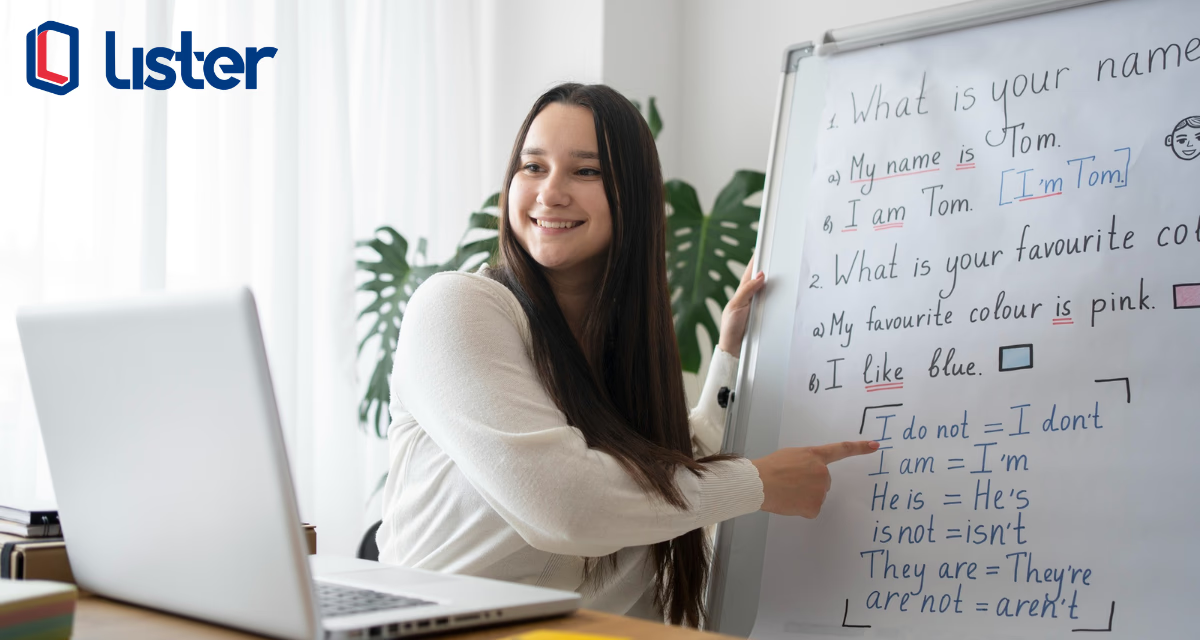Untuk naik level kemampuan bahasa Inggris, kamu juga harus menaikkan level bacaan bahasa Inggris yang kamu punya. Salah satunya melalui artikel bahasa Inggris dalam berbagai tema seperti yang ada dalam artikel ini. Kamu juga bisa mulai belajar bahasa Inggris di Lister untuk mendapatkan arahan yang tepat dan target belajar yang jelas.
Baca juga: Yuk Pelajari Struktur Artikel Bahasa Inggris
Contoh Artikel Bahasa Inggris Singkat
Contoh Artikel Bahasa Inggris Tentang Kesehatan
Staying Healthy
Source: www.health.harvard.edu
Maintaining good health doesn’t happen by accident. It requires work, smart lifestyle choices, and the occasional checkup and test.
A healthy diet is rich in fiber, whole grains, fresh fruits and vegetables, “good” or unsaturated fats, and omega-3 fatty acids. These dietary components turn down inflammation, which can damage tissue, joints, artery walls, and organs. Going easy on processed foods is another element of healthy eating. Sweets, foods made with highly refined grains, and sugar-sweetened beverages can cause spikes in blood sugar that can lead to early hunger. High blood sugar is linked to the development of diabetes, obesity, heart disease, and even dementia.
The Mediterranean diet meets all of the criteria for good health, and there is convincing evidence that it is effective at warding off heart attack, stroke, and premature death. The diet is rich in olive oil, fruits, vegetables, nuts and fish; low in red meats or processed meats; and includes a moderate amount of cheese and wine.
Physical activity is also necessary for good health. It can greatly reduce your risk of heart disease, stroke, type 2 diabetes, breast and colon cancer, depression, and falls. Physical activity improves sleep, endurance, and even sex. Aim for 150 minutes of moderate-intensity exercise every week, such as brisk walking. Strength training, important for balance, bone health, controlling blood sugar, and mobility, is recommended 2-3 times per week.
Finding ways to reduce stress is another strategy that can help you stay healthy, given the connection between stress and a variety of disorders. There are many ways to bust stress. Try, meditation, mindfulness, yoga, playing on weekends, and taking vacations.
Finally, establish a good relationship with a primary care physician. If something happens to your health, a physician you know —and who knows you — is in the best position to help. He or she will also recommend tests to check for hidden cancer or other conditions.
Contoh Artikel Bahasa Inggris Tentang Alam
How Does Nature Impact Our Wellbeing?
Source: www.takingcharge.csh.umn.edu
Research reveals that environments can increase or reduce our stress, which in turn impacts our bodies. What you are seeing, hearing, experiencing at any moment is changing not only your mood, but how your nervous, endocrine, and immune systems are working.
The stress of an unpleasant environment can cause you to feel anxious, or sad, or helpless. This in turn elevates your blood pressure, heart rate, and muscle tension and suppresses your immune system. A pleasing environment reverses that.
And regardless of age or culture, humans find nature pleasing. In one study cited in the book Healing Gardens, researchers found that more than two-thirds of people choose a natural setting to retreat to when stressed.
Contoh Artikel Bahasa Inggris Tentang Makanan
Healthy Food Reading
Source: www.ecenglish.com
As the weather gets colder it is more and more important to take care of your health as bugs and viruses are everywhere. A great way to do this is to change the way you eat. Although we may want comforting ‘fatty foods’ at this time of year, eating healthily can help us to enjoy an illness-free winter.
As always, eating plenty of fruit and vegetables is of key importance to your health as it provides you with a wide range of vitamins. We say ‘An apple a day keeps the doctor away’ for a reason; they are packed with Vitamin A and C and are easy to carry around in your bag. Oranges are also fantastic but some people are put off them because of the stringy texture of their skin. Invest in a cheap juicer (you can find them for £1) and make your own fresh orange juice, that way you can enjoy all the benefits without any of the fuss.
For dinner, try to get into the habit of eating more fish. According to studies, eating salmon once a week can lower the risk of heart attacks by half and also lowers blood pressure.
In general, just try to avoid processed food and fatty snacks. Replace a packet of crisps with a handful of nuts and a burger and chips with grilled chicken and baked potato. Remember to supplement this healthy eating by drinking lots of water and enjoy a germ-free season!
Contoh Artikel Bahasa Inggris Tentang Sampah
Here’s Where the Ocean’s Trash Comes From
Source: www.nationalgeographic.org
Outdoor photographer Zak Noyle has seen his share of marine debris, but he was shocked by what he discovered on an assignment in a remote spot off the coast of Java. There to cover Indonesian surfer Dede Suryana in 2012, Noyle found himself literally swimming in a sea of garbage. “It was overwhelming,” he recalls. “I really thought we were going to see a dead body in the water.”
Roughly eight million tons of plastic enters the ocean every year. That’s according to a 2015 report, which also identified where the bulk of this trash originates. At the top of the list: China, the Philippines, and Indonesia.
Sightings of junk-filled waters are common—and not only in Southeast Asia, says marine biologist Nicholas Mallos, who runs the Ocean Conservancy’s Trash Free Seas program. “Accumulations like this are unfortunately the norm,” he says, particularly in developing parts of the world where there are “rising middle-class populations along coastlines, and spending and consumption have increased, but waste management has not.”
Though trash remains a global problem, Mallos sees reasons to be hopeful. In the United States, for example, California voters in 2016 upheld a statewide ban on plastic bags. And in Indonesia, he says, there has been a shift in awareness: “We’re seeing an eager and willing group of stakeholders who are trying to step up and tackle these issues.” Put another way: The tide may be turning.
Originally published by National Geographic Magazine and by natgeo.com in April 2017.
Contoh Artikel Bahasa Inggris Tentang Pendidikan Anak Usia Dini
Helping Your Child Adjust to Preschool
Preschool offers many benefits. It can be a great place for kids to interact with peers and learn valuable life lessons such as how to share, take turns, and follow rules. It also can prepare them academically for kindergarten and beyond.
But going to preschool does come with some emotions, for both the parent and the child. For a child, entering a new preschool environment filled with unfamiliar teachers and kids can cause both anxiety and excitement. Parents might have mixed emotions about whether their child is ready for preschool.
Getting comfortable with your decision and the preschool setting can help you and your child feel ready.
Easing Your Child’s Fears
Spend time talking with your child about preschool before it starts. In the months and weeks before school, gradually introduce your child to activities that often take place in a classroom. A child who’s used to scribbling with paper and crayons at home, for example, will find it comforting to discover the crayons and paper in the preschool classroom.
Visit the preschool classroom with your child a few times before school starts. This can ease concerns about this unfamiliar territory. Visiting is also a chance to meet your child’s teacher and ask questions about routines and common activities. You can introduce some of those routines and activities at home so they become familiar.
While you’re in the classroom, let your child explore and observe the class and choose whether to interact with other kids. This helps familiarize kids with the classroom and lets them explore the new toys they’ll play with when school starts.
You can also ask how the teacher handles the first tear-filled days. How will the first week be structured to make the transition smooth for your child?
While acknowledging this important step your child is taking and providing support, too much emphasis on the change could make any anxiety worse. Young kids can pick up on their parents’ nonverbal cues. When parents feel guilty or worried about leaving their child at school, the kids will probably sense that.
The more calm and assured you are about your choice to send your child to preschool, the more confident your child will be.
The First Day
When you enter the classroom on the first day, calmly reintroduce the teacher to your child, then step back to allow the teacher to begin forming a relationship with your child. Your endorsement of the teacher will show your child that he or she will be happy and safe in the teacher’s care.
If your child clings to you or refuses to participate in the class, don’t get upset — this may only upset your child more. Always say a loving goodbye to your child, but once you do, leave promptly. Don’t sneak out. As tempting as it may be, leaving without saying goodbye can make kids feel abandoned. A long farewell, on the other hand, might only reinforce a child’s sense that preschool is a bad place.
A consistent and predictable farewell routine can make leaving easier. Some parents wave from outside the classroom window or make a funny goodbye face, while others have a special handshake before parting. Transitional objects — a family picture, a special doll, or a favorite blanket — can also help comfort a child. Also, keep in mind that most kids do well after their parents leave.
Whether your child is eager or reluctant to go to preschool, make sure that a school staff member is ready to help with the transfer when you arrive. Some kids may jump right in with their classmates, while others might want a private cuddle from a caregiver before joining the group.
Many preschools begin with a daily ritual, such as circle time (when teachers and children talk about what they did the day before and the activities that are ahead for the day). Preschoolers tend to respond to this kind of predictability, and following a routine will help ease the move from home to school.












